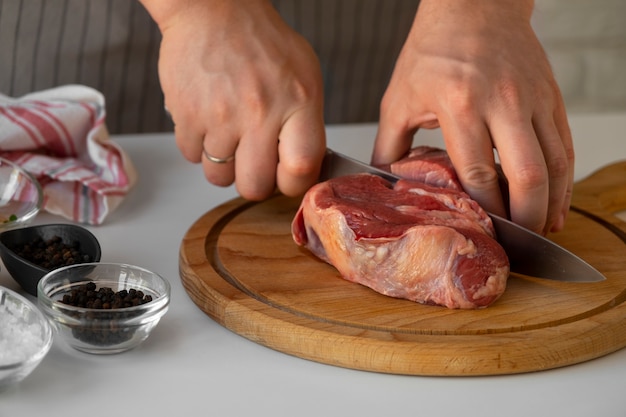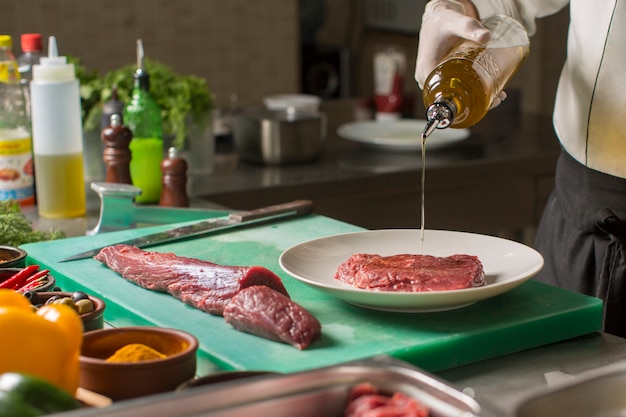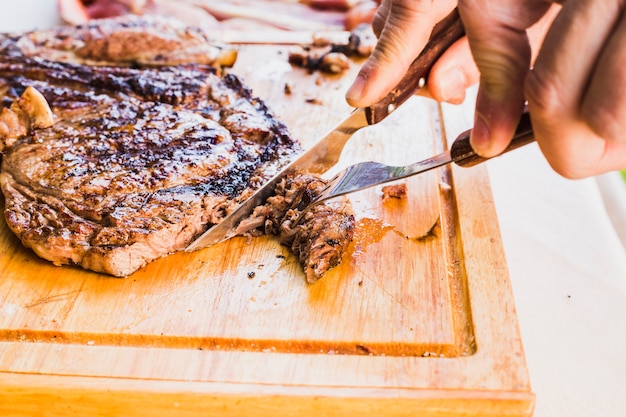Let's talk steak, my friends! Not just any steak, but the delightful petite sirloin – a cut that's got a good balance of flavour and tenderness. Now, I'm not just some bloke who throws a piece of meat on the barbie, I've been on a bit of a journey, exploring different cuts, techniques, and everything in between. And you know what? I've learned a thing or two along the way.
Petite sirloin, with its lean profile and satisfying flavour, holds a special place in my heart. But like any good steak, it needs to be treated right to reach its full potential. So, grab your trusty frying pan, crank up the oven, or get that grill roaring – we're about to unlock the secrets to cooking petite sirloin to absolute perfection.
(Part 1) Choosing the Perfect Petite Sirloin

Understanding the Cut
Petite sirloin, for those who aren't familiar, is a smaller, more tender cut taken from the sirloin section of the cow. It's often a bit more affordable than a full sirloin and cooks up beautifully. But, there's more to choosing a great petite sirloin than just grabbing the first packet you see.
Look for Marbling: The Key to Juiciness
The secret to a juicy, flavourful steak is marbling. That's the fat that's beautifully interspersed throughout the muscle, giving you that melt-in-your-mouth tenderness. Keep an eye out for steaks with good marbling – it should be evenly distributed, not just a few streaks here and there.
Now, you can find petite sirloin in different grades of marbling. If you're after something leaner, look for a cut labelled "select" or "choice" – they'll have less marbling. But, if you want a truly flavourful experience, go for "prime" or even "wagyu" – those are the big guns, offering a richer, more decadent experience.
The Thickness: Finding the Sweet Spot
For petite sirloin, you want a thickness of about 1 inch or so. Any thinner, and it's going to be tough to cook evenly. Any thicker, and you'll need a longer cooking time, which might dry out the steak. If you find a really thick one, you can always ask your butcher to slice it into two or three steaks – that's what I do sometimes, especially if I'm feeding a crowd.
Fresh is Best: The Importance of Quality
This one's a no-brainer, really. Always go for fresh steak, preferably from a reputable butcher. You can usually tell if a steak's been hanging around too long by its colour and texture. Fresh steak will have a deep, rich red colour and a firm texture. If it's looking a bit dull and slimy, you're better off putting it back and finding something fresher.
(Part 2) The Art of Seasoning: Less is More

Keep It Simple: Salt and Pepper are Your Best Friends
I know, I know, there are a million different fancy steak rubs and seasonings out there. But, sometimes, less is more. A good quality steak doesn't need a whole lot of fuss. Just a pinch of salt and freshly ground black pepper is usually all you need to let the natural flavours shine.
Salt Before You Cook: The Secret to a Great Crust
I've always been a "salt before you cook" kind of guy. Salt draws out moisture from the surface of the steak, which helps to create a nice sear and crust. But, it can also make the steak tougher if you overdo it, so just a sprinkle is enough. Do it about 30 minutes before you cook and let it sit on a wire rack to let the moisture evaporate. This will help to create a beautiful, crispy crust.
Experiment with Herbs and Spices: Add a Touch of Flair
Now, if you're feeling a bit adventurous, there's nothing stopping you from adding a little something extra. Garlic powder, paprika, oregano – the possibilities are endless! But, I'd recommend using them sparingly, and make sure you add them right before you cook so they don't burn.
(Part 3) Mastering the cooking techniques: From Pan to Grill to Oven

Pan-Seared Perfection: The Classic Approach
This is my go-to method for a petite sirloin. It's quick, easy, and produces a delicious, crusty steak.
Step-by-Step Guide:
- Get your pan ripping hot. Cast iron is the best, but a good quality stainless steel pan will do the trick. Add a tablespoon or two of oil, and make sure it's nice and hot before you add the steak. You can test it by flicking a few drops of water onto the pan – if they sizzle and evaporate immediately, it's ready.
- Sear the steak for 2-3 minutes per side, or until it's nicely browned. This will create a crispy crust and seal in the juices. Don't overcrowd the pan – you want the steak to have space to cook evenly.
- Reduce the heat to medium-low, and continue cooking for another 3-5 minutes per side, depending on how well done you like your steak. You can use a meat thermometer to check the internal temperature. Medium-rare is around 130°F, medium is around 140°F, and medium-well is around 150°F.
- Once the steak is cooked to your liking, take it off the heat and let it rest for 5-10 minutes before slicing. This will allow the juices to redistribute, resulting in a more tender and juicy steak.
Grill It Up: Smoky Flavour and Beautiful Grill Marks
If you're lucky enough to have a grill, you can take your petite sirloin to a whole new level. It's the perfect way to enjoy that smoky flavour and those beautiful grill marks.
Step-by-Step Guide:
- Preheat your grill to medium-high heat. You want the grill grates to be nice and hot, but not too hot that the steak burns before it's cooked through.
- Clean the grill grates with a wire brush to remove any food debris. This will prevent your steak from sticking and will help to give you those beautiful grill marks.
- Place the steak on the grill and cook for 2-3 minutes per side, or until it's nicely browned. You want to get those grill marks, so don't move the steak too much.
- Reduce the heat to medium, and continue cooking for another 3-5 minutes per side, depending on how well done you like your steak.
- Once the steak is cooked to your liking, take it off the grill and let it rest for 5-10 minutes before slicing.
Oven-Roasted Delights: A Convenient Option
You can also cook petite sirloin in the oven, which is great if you're cooking a larger batch or you're not keen on the pan or grill method.
Step-by-Step Guide:
- Preheat your oven to 400°F. This will help the steak to cook evenly and quickly.
- Place the steak on a baking sheet lined with parchment paper. This will prevent it from sticking to the sheet.
- Cook the steak for 10-12 minutes for medium-rare, 12-14 minutes for medium, and 14-16 minutes for medium-well. Check the internal temperature with a meat thermometer to make sure it's cooked to your liking.
- Take the steak out of the oven and let it rest for 5-10 minutes before slicing.
(Part 4) Temperature and Timing: The Secrets to Perfection
Using a Meat Thermometer: Your Steak's Best Friend
The most reliable way to ensure your steak is cooked to your liking is to use a meat thermometer. Insert the thermometer into the thickest part of the steak, making sure it doesn't touch any bone.
Internal Temperature Guide: Knowing Your Doneness
Here's a quick guide to internal temperatures for different levels of doneness. Remember, everyone has their preferences, so find what you enjoy:
| Level of Doneness | Internal Temperature (°F) |
|---|---|
| Rare | 125-130°F |
| Medium-Rare | 130-135°F |
| Medium | 135-140°F |
| Medium-Well | 140-150°F |
| Well Done | 150-160°F |
Resting is Key: Unlocking Juiciness
Resting is absolutely crucial for a tender, juicy steak. When you take a steak off the heat, it continues to cook a little bit, and resting allows the juices to redistribute throughout the steak, making it more evenly cooked and delicious.
(Part 5) The Wonderful World of Sauces and Sides: Completing Your Masterpiece
Simple and Delicious: Letting the Steak Shine
A petite sirloin doesn't need much fuss when it comes to sauces. You want to let the natural flavour of the steak shine through.
Here are a few ideas:
- A splash of butter and a sprinkle of herbs: This is a classic for a reason – it's simple and delicious. Let the steak rest for a couple of minutes, then add a knob of butter to the pan, swirl it around, and pour it over the steak. A sprinkle of fresh herbs like parsley or thyme adds a finishing touch.
- A simple pan sauce: Deglaze the pan you used to cook the steak with a little red wine or broth, scraping up the browned bits on the bottom. Add a splash of vinegar or lemon juice for a bit of acidity, and let it simmer until it thickens slightly. You can add a knob of butter at the end for extra richness.
- Aioli or chimichurri: These are both great options for adding flavour and zing. Try aioli, a garlic-based sauce, or chimichurri, a vibrant blend of herbs, garlic, and olive oil.
Complementary Sides: Adding Texture and Freshness
When it comes to sides, you want to choose something that complements the flavour of the steak and adds a bit of texture and freshness.
Here are a few ideas:
- Roasted vegetables: roasted asparagus, Brussels sprouts, or carrots are all delicious side dishes for steak. They're easy to make and provide a good dose of flavour and nutrients.
- mashed potatoes: They're a classic comfort food that goes great with steak. You can elevate them by adding a dollop of sour cream or a sprinkle of fresh herbs.
- Salad: A simple salad with mixed greens, tomatoes, and cucumbers can add a fresh and light touch to your meal.
(Part 6) Making the Most of Your Steak Leftovers: Delicious Second Acts
Steak Sandwiches: A Classic for a Reason
Steak leftovers are a true blessing. One of the best things to do with leftover steak is to make a delicious sandwich. Slice the steak thinly and pile it onto a toasted bun with your favourite toppings – cheese, onion, pickles, and mayo all work well. You can even get creative with a bit of sriracha for a touch of spice.
Steak Salad: A Light and Satisfying Meal
Another great way to use up leftover steak is to add it to a salad. Chop the steak into bite-sized pieces and add it to a bed of mixed greens with your favourite vegetables and dressing. It's a light and satisfying meal, perfect for lunch or dinner.
Steak Soup: Hearty and Comforting
If you're looking for a hearty and comforting meal, you can use leftover steak to make a delicious soup. Dice the steak and add it to a base of broth, vegetables, and herbs. Let it simmer until the flavours have meld. It's a great way to warm up on a chilly day.
(Part 7) Top Tips for Steak Success: Mastering the Art
Don't Be Afraid to Experiment: Finding Your perfect steak
When it comes to cooking steak, there's no one right way. Experiment with different cooking methods, seasonings, and sides to find your perfect combination. The best steak is the one you enjoy the most, so don't be afraid to explore and find your own style.
Don't Overcook It: Keeping it Tender and Juicy
Overcooking steak is a common mistake. Overcooked steak is tough and dry. Use a meat thermometer to check the internal temperature and aim for the desired level of doneness. Trust me, a perfectly cooked steak is a revelation.
Let it Rest: The Key to Tenderness
As we've already mentioned, resting is key for a juicy, tender steak. Resting allows the juices to redistribute throughout the steak. Give it at least 5-10 minutes before slicing. You'll be amazed by the difference it makes.
Get the Right Equipment: Invest in the Essentials
A good quality frying pan or grill, a meat thermometer, and a sharp knife are all essential tools for cooking steak. Invest in quality tools, and they'll serve you well for years to come.
Don't Be Afraid to Ask for Help: Tap into Expertise
If you're feeling overwhelmed, don't be afraid to ask for help. A good butcher or chef can give you great advice on choosing the right cut of meat, seasoning it properly, and cooking it to perfection. Don't be afraid to tap into the expertise of those who know best.
(Part 8) FAQs: Addressing Your Steak Concerns
1. How do I know if my steak is cooked to the right level of doneness?
The best way to tell is to use a meat thermometer. Insert it into the thickest part of the steak, making sure it doesn't touch any bone. The internal temperature will indicate the level of doneness. If you don't have a meat thermometer, you can use the "touch test." Press the steak with your finger – if it feels firm, it's well done, if it feels springy, it's medium, and if it feels soft, it's rare. However, this method is less accurate than using a meat thermometer.
2. What's the best way to store leftover steak?
Refrigerate leftover steak in an airtight container. It will stay fresh for 3-4 days. You can also freeze leftover steak for up to 3 months. To freeze it, wrap it tightly in plastic wrap or aluminum foil.
3. Can I cook petite sirloin in the microwave?
I wouldn't recommend it. Microwaving a steak will likely result in a tough and dry steak. It's best to stick with other cooking methods like pan-searing, grilling, or roasting.
4. What's the difference between a petite sirloin and a regular sirloin?
A petite sirloin is a smaller cut of sirloin. It's often more tender than a regular sirloin because it's less likely to have tough connective tissues. It's a great choice for a smaller meal or if you're serving one or two people.
5. How can I make sure my steak doesn't dry out?
The key to avoiding dry steak is to cook it evenly and to rest it properly. Don't overcook the steak, and let it rest for 5-10 minutes before slicing. This will allow the juices to redistribute throughout the steak, resulting in a juicy and tender steak.
I hope this guide has helped you to understand the basics of cooking petite sirloin steak. Now, go forth and enjoy the deliciousness of a perfectly cooked steak!
Everyone is watching

Corn on the Cob: The Ultimate Guide to Perfectly Cooked Ears
Healthy MealsAh, corn on the cob. Just the name evokes images of sunny days, barbecues, and that sweet, juicy flavour that ...

Perfect Pork Roast Oven Cooking Time: A Guide to Delicious Results
Healthy MealsThere's something truly satisfying about a perfectly roasted pork. The aroma alone is enough to make your mout...

Ham Cooking Time: How Long to Bake, Smoke, or Boil a Delicious Ham
Healthy MealsAh, ham. It's a classic, isn't it? A real crowd-pleaser, especially around holidays. And when done right, it'...

Scallops: The Ultimate Guide to Perfect Cooking
Healthy MealsAh, scallops. Those delicate, sweet, and utterly delicious morsels of the sea. They hold a special place in my...

Spaghetti Squash: The Ultimate Guide to Cooking and Serving
Healthy MealsRemember that time you saw spaghetti squash at the supermarket, looking all bumpy and strange, and thought, "W...
